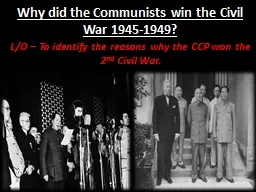

LO To identify the reasons why the CCP won the 2 nd Civil War China in 1945 When war ended in Aug 1945 the CCP controlled most of the countryside amp the KMT was stuck in Sichuan province ID: 243527
Download Presentation The PPT/PDF document "Why did the Communists win the Civil War..." is the property of its rightful owner. Permission is granted to download and print the materials on this web site for personal, non-commercial use only, and to display it on your personal computer provided you do not modify the materials and that you retain all copyright notices contained in the materials. By downloading content from our website, you accept the terms of this agreement.
Slide1
Why did the Communists win the Civil War 1945-1949?
L/O – To identify the reasons why the CCP won the 2nd Civil War.Slide2
China in 1945
When war ended in Aug 1945, the CCP controlled most of the countryside
& the KMT was stuck in Sichuan province.The war ended too soon for Chiang. He was hoping that the USA would
send armies
to China to defeat the Japanese
AND communists.The CCP was already accepting the surrender of the Japanese in many areas and taking over.
‘
The CCP had effectively won the civil war by 1945
.’
Do you agree? Explain your opinions in details. Think back to last lessonSlide3Slide4
China in 1945
The Allies decided that Chiang should be reinstated as ruler of China. Even Stalin
agreed to this.US Dakota planes rushed 110,000 KMT troops to
the cities and bases in the north to accept the surrender of
Japanese troops & equipment
before the Communists could do so.In response the Communists moved into Manchuria and captured many ex-Japanese weapons.
Why do you think Stalin agreed to reinstate Chiang rather than Mao as leader of China?Slide5
Ceasefire?
In Dec 1945, the USA sent General Marshall
to try to prevent a civil war in China. He failed and war broke out in early 1946.The Communists had 1.2m members, 900,000 soldiers, 19 base areas, 90m population but lacked heavy military equipment and only 600 artillery pieces.
KMT had
2.7m soldiers
, 39 newly trained divisions, x10 artillery and large air force.Was there any realistic prospect of peace cooperation between the CCP & KMT after the end of WW2?Slide6
1.) Early Setbacks, July 1946-May 1947
The KMT immediately took the initiative by launching an offensive which captured most of the cities of Manchuria except for Harbin
in the far north.The CCP even lost their base at Yan’an. KMT numbers, resources and air power helped dramatically
. Chiang committed
½ million
of his best troops to capture Manchuria. A renewed offensive by the KMT in Oct 1946 failed to break through PLA defences.Slide7Slide8
1.) Early Setbacks, July 1946-May 1947
After October 1946, the PLA led by Lin Biao, began to adopt an effective guerrilla warfare
strategy against the KMT.From rural bases, the PLA ambushed KMT units, forcing them to remain in the cities.
Railway lines were then blown up to cut the cities off from
supplies
and reinforcements. Slide9Slide10
2.) Seizing the Initiative, May 1947-Nov 1948
During this period, the PLA moved from a strategy of guerrilla warfare to one of conventional battles
with massed forces of infantry and artillery.In June 1948, the PLA captured the Yellow River valley
,
Shandong Province
and in October, Manchuria finally fell.Chiang had lost over ½ million of his best troops and was now on the defensive.
Why was it important to move from guerrilla warfare to conventional warfare?Slide11Slide12
3. The Final Stages, Dec 1948-Oct 1949
Moving quickly to capitalise on successes, the PLA launched an offensive against the vital railway junction of Xuzhou.
The battle lasted 65 days with 600,000 on each side. Xuzhou was captured in Jan 1949 along with Beijing
and
Tianjin
by Lin Biao in the same month.By Feb 1949, the whole of northern China was controlled by the Communists. Slide13Slide14
3. The Final Stages, Dec 1948-Oct 1949
After a rest, in April 1949, the PLA attacked key cities on the Yangtzi River, capturing
Nanjing on 23rd April and Shanghai in late May.
Wuhan
was captured in May and the way to the south was now open. The army then divided:
Xi’an & Lanzhou captured in August.Guangzhou captured in October.Chongqing captured in November.Slide15Slide16
The People’s Republic of China (PRC)
By late Sep 1949, most of China was under Communist control.
Mao called a conference in Beijing. 14 political parties were represented and the conference elected members of the new central government of the People’s Republic of China (PRC)
.
On
1st Oct 1949, Mao proclaimed the founding of the PRC and he was elected Chairman.Chiang Kai-Shek
fled to the island of Taiwan and established a KMT government.Slide17